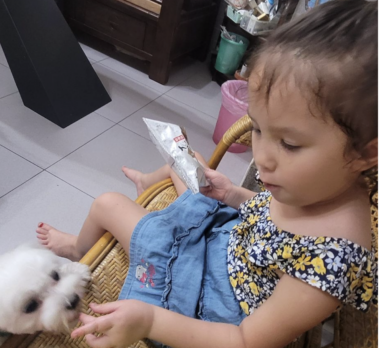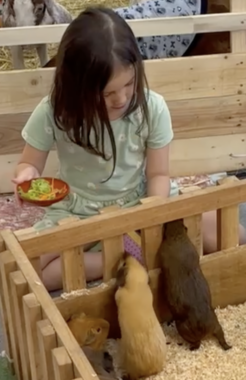Reconsidering the benefits of therapy dogs after a trip to the mall
A pet could help our daughter continue to make progress with AADC deficiency
Written by |

My daughter, Rylae-Ann, followed me and my wife, Judy, into the mall for routine shopping. We were greeted with whimpers and yelps from various furry friends as soon as we entered. Rylae-Ann needed no encouragement. She went straight to the pen of puppies and grabbed one to snuggle with.
Growing up, I got my first dog when I was in kindergarten. She was a black Labrador retriever named Midnight and my best friend. After she passed, I couldn’t think of getting another dog. Plus, once I was a teenager, I was focused more on hanging out with friends.
Judy never had such experiences growing up and was never fond of the shedding, drooling, and jumping that dogs are known for. I always dreamed of getting another dog when my children were at the appropriate age. But when Rylae-Ann was born, all of my expectations and grandiose plans for parenthood instantly evaporated. She was diagnosed with a rare and deadly genetic neurotransmitter disease known as aromatic l-amino acid decarboxylase (AADC) deficiency.
Fortunately, Rylae-Ann received gene therapy when she was 18 months old. It was a long road to catching up on missed developmental milestones, such as grabbing, belly time, rolling over, and crawling. Slowly but surely, she made great progress with gross and fine motor skills. She also improved in speech, reading, and writing. But she continues to struggle with anxiety.

Rylae-Ann relaxes and sits quietly, feeding her new friend. (Photo by Richard E. Poulin III)
Her anxiety level causes her to act out and have poor behavior. Other times, it makes her scared to the point where she refuses to do certain activities, wailing and rolling on the ground to avoid them. The poor choices have also carried over to friendships, which were already difficult for her.
As we walked into the mall, we were met with an array of puppy dog eyes, and we were all changed.
Decision making
Judy and I have known for a long time that dogs act as powerful therapy companions. We never capitalized on it, though, because we were always traveling and spent much time caring for Rylae-Ann. Over time, she has grown more independent and required less care. It seems we may be at the perfect point in our journey to buy a dog.
However, we didn’t buy a dog that day. We didn’t want to regret our decision later or let impulsiveness control our decision making. That wouldn’t be fair to anyone. Also, we must fly back to Taiwan in a couple weeks to continue Rylae-Ann’s health tests and contribute data to a clinical study that observes the long-term effects of gene therapy.
It didn’t seem right to leave our new family member in the first few weeks it was with us. Instead, we spent time researching the perfect dog breed.
Researching therapy dogs

Rylae-Ann shows improved empathy and social skills by caring for pets. (Photo by Richard E. Poulin III)
Right away, nostalgia made me want the research to arrive at a Labrador. While they’re excellent dogs, their large size wouldn’t suit Rylae-Ann’s immediate purpose. Also, Judy wasn’t sold on the idea of cleaning up mats of fallen hair from the floor.
At the mall, Rylae-Ann snuggled with puppies and caressed their curly coats. She sat uninterrupted for 30 minutes — a length of focus time we’ve only seen when she rides horses.
We arrived at a good compromise with a labradoodle — a crossbreed of Labrador retrievers and poodles. Labradoodles are a great option for a therapy animal because of their friendly, gentle, and intelligent nature. Judy liked the fact that their coats are hypoallergenic and don’t shed as much. Labradoodles could also help Rylae-Ann improve her social skills and temperament.
Like many therapy dogs, labradoodles form strong bonds with their owners. They’re excellent at providing emotional support and comfort. Additionally, their playful and energetic demeanor can encourage physical activity and engagement, making them versatile companions in various therapeutic settings, such as hospitals, schools, and other activities.
After our summer break ends and we return to our routine lifestyle, Judy and I will buy Rylae-Ann a labradoodle. Therapy dogs offer a unique blend of companionship, emotional support, and physical benefits, making them valuable in a wide range of therapeutic contexts. We hope this will help Rylae-Ann continue to make tremendous improvements on our journey together.
Note: AADC News is strictly a news and information website about the disease. It does not provide medical advice, diagnosis, or treatment. This content is not intended to be a substitute for professional medical advice, diagnosis, or treatment. Always seek the advice of your physician or other qualified health provider with any questions you may have regarding a medical condition. Never disregard professional medical advice or delay in seeking it because of something you have read on this website. The opinions expressed in this column are not those of AADC News or its parent company, Bionews, and are intended to spark discussion about issues pertaining to aromatic l-amino acid decarboxylase deficiency.





Leave a comment
Fill in the required fields to post. Your email address will not be published.